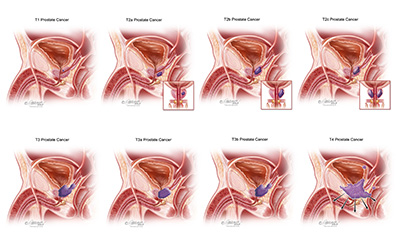
Prostate cancer is grouped into four stages. The stages are defined by how much and how quickly the cancer cells grow. The stages are defined by the Gleason Score and the T (tumor), N (node), M (metastasis) Score.
Gleason Score
If a biopsy results in cancer, the pathologist gives it a grade. The most common grading system is called the Gleason grading system. The Gleason score is a measure of how quickly cancer cells can grow and affect other tissue. Biopsy samples are taken from the prostate and given a Gleason grade by a pathologist. Lower grades are given to samples with small, closely packed cells. Higher grades are given to samples with more spread-out cells. The Gleason score is set by adding together the two most common grades found in a biopsy sample.
The Gleason score will help your health care team understand if the cancer is a low-, intermediate- or high- risk disease. The risk assessment is the risk of recurrence after treatment. Generally, Gleason scores of 6 are treated as low-risk cancers. Gleason scores of around 7 are treated as intermediate/mid-level cancers. Gleason scores of 8 and above are treated as high-risk cancers. Some of these high-risk tumors may have already spread by the time they are found.
Staging
Tumor, Nodes and Metastasis (TNM) staging system is the system used for tumor staging. The T, N, M Score is a measure of how far prostate cancer has spread in the body. The T (tumor) score rates the size and extent of the original tumor. The N (nodes) score rates whether the cancer has spread into nearby lymph nodes. The M (metastasis) score rates whether the cancer has spread to distant sites.
Tumors found only in the prostate are more successfully treated than those that have metastasized (spread) outside the prostate. Tumors that have metastasized are incurable and require drug-based therapies to treat the whole body.
Prostate Cancer Stage Groupings
Prostate cancer is staged as:
- T1: Health care provider cannot feel the tumor
- T1a: Cancer present in less than 5% of the tissue removed and low grade (Gleason less than 6)
- T1b: Cancer present in more than 5% of the tissue removed or is of a higher grade (Gleason greater than 6)
- T1c: Cancer found by needle biopsy done because of a high PSA
- T2: Health care provider can feel the tumor with a DRE, but the tumor is confined to the prostate
- T2a: Cancer found in one half or less of one side (left or right) of the prostate
- T2b: Cancer found in more than half of one side (left or right) of the prostate
- T2c: Cancer found in both sides of the prostate
- T3: Cancer has begun to spread outside the prostate and may involve the seminal vesicles
- T3a: Cancer extends outside the prostate but not to the seminal vesicles
- T3b: Cancer has spread to the seminal vesicles
- T4: Cancer has spread to nearby organs
- N0: There is no sign of the cancer moving to the lymph nodes in the area of the prostate (becomes N1 if cancer has spread to lymph nodes)
- M0: There is no sign of tumor metastasis (becomes M1 if cancer has spread to other parts of the body)



